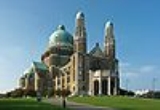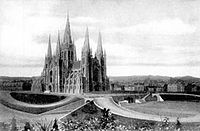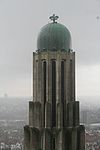
Basilica of the Sacred Heart, Belgium
Encyclopedia
The National Basilica of the Sacred Heart is a Roman Catholic Minor Basilica
and parish church
in Brussels. The church was dedicated to the Sacred Heart
, inspired by the Basilique du Sacré-Coeur in Paris. Symbolically King Leopold II laid the first stone of the basilica in 1905 during the celebrations of the 75th anniversary of Belgian independence. The construction was halted by the two World War
s and wasn't finished until 1969. Belonging to the Metropolitan Archbishopric of Mechelen-Brussels, it is one of the ten largest Roman Catholic church by area in the world.
Located in the Parc Elisabeth atop the Koekelberg Hill in Brussels' Koekelberg
municipality, the church is popularly known as the Koekelberg Basilica ( or ). The massive brick and concrete reinforced church features two thin towers and a green copper dome that rises 89 metres (292 ft) above the ground, dominating the northwestern skyline of Brussels
.
dreamed of turning the uninhabited Koekelberg hill into a royal residence area. After his death, just before 1880, King Leopold II
envisaged building a Belgian Panthéon dedicated to Great Belgians, inspired by the French Panthéon
in Paris, to commemorate the 50th anniversary of Belgian independence. The King dropped this project due to the lack of enthusiasm of the Belgian population. In 1902, King Leopold II visited the Basilique du Sacré-Coeur of Paris and decided to build instead a pilgrimage church, a national sanctuary dedicated to the Sacred Heart
of Jesus.
 The initial project of Leuven
The initial project of Leuven
-based architect Pierre Langerock was a sumptuous neo-gothic church inspired by the "ideal cathedral" of Eugène Viollet-le-Duc
.
King Leopold II
laid the first stone on 12 October 1905 during the celebrations commemorating the 75th anniversary of Belgian independence. Financing the construction of the church soon became a problem. Only the foundations had been finished when World War I broke out. In his pastoral letter for Christmas 1914, Cardinal Mercier gave the Basilica a new meaning:
Cardinal Jozef-Ernest van Roey
consecrated the unfinished church on 14 October 1935, after obtaining a special authorisation from Pope Pius XI
. The cupola was finished in 1969 and, on 11 November 1970, the ceremony for the 25th anniversary of the episcopate of Archbishop of Mechelen-Brussels Cardinal Leo Joseph Suenens
marked the completion of the construction of the Basilica.
The final design by architect Albert Van Huffel won the great architecture prize at the Exposition Internationale des Arts Décoratifs et Industriels Modernes
in Paris.
 The church, on Koekelberg hill, is a landmark on the Brussels
The church, on Koekelberg hill, is a landmark on the Brussels
skyline. It is the largest building in Art Deco
style in the world, at 89 m (292 ft) high and 164.5 m (539.7 ft) long (outside length). The cupola
platform affords an excellent city panoramic view of Brussels
and the wider area of Flemish-Brabant. The central nave
is 141 m (462.6 ft) long, and at its widest the building is 107 m (351 ft). The cupola
has a diameter
of 33 m (108.3 ft). The church accommodates 2000 people.
The building combines reinforced concrete with terracotta layering, bricks, and dimension stone
. Belgian painter Anto Carte (1886–1954) designed the eight stained glass windows representing the life of Jesus.
and French), as well as conferences, exhibitions (as in 2007–2008, the International Leonardo da Vinci
Expo), a restaurant, a Catholic radio station, a theatre and two museums.
Minor basilica
Minor basilica is a title given to some Roman Catholic churches. By canon law no Catholic church can be honoured with the title of basilica unless by apostolic grant or from immemorial custom....
and parish church
Parish church
A parish church , in Christianity, is the church which acts as the religious centre of a parish, the basic administrative unit of episcopal churches....
in Brussels. The church was dedicated to the Sacred Heart
Sacred Heart
The Sacred Heart is one of the most famous religious devotions to Jesus' physical heart as the representation of His divine love for Humanity....
, inspired by the Basilique du Sacré-Coeur in Paris. Symbolically King Leopold II laid the first stone of the basilica in 1905 during the celebrations of the 75th anniversary of Belgian independence. The construction was halted by the two World War
World war
A world war is a war affecting the majority of the world's most powerful and populous nations. World wars span multiple countries on multiple continents, with battles fought in multiple theaters....
s and wasn't finished until 1969. Belonging to the Metropolitan Archbishopric of Mechelen-Brussels, it is one of the ten largest Roman Catholic church by area in the world.
Located in the Parc Elisabeth atop the Koekelberg Hill in Brussels' Koekelberg
Koekelberg
Koekelberg is one of the nineteen municipalities located in the Brussels-Capital Region of Belgium. On January 1, 2006 the municipality had a total population of 18,157...
municipality, the church is popularly known as the Koekelberg Basilica ( or ). The massive brick and concrete reinforced church features two thin towers and a green copper dome that rises 89 metres (292 ft) above the ground, dominating the northwestern skyline of Brussels
Brussels
Brussels , officially the Brussels Region or Brussels-Capital Region , is the capital of Belgium and the de facto capital of the European Union...
.
History
Mid-19th century, King Leopold ILeopold I of Belgium
Leopold I was from 21 July 1831 the first King of the Belgians, following Belgium's independence from the Netherlands. He was the founder of the Belgian line of the House of Saxe-Coburg-Gotha...
dreamed of turning the uninhabited Koekelberg hill into a royal residence area. After his death, just before 1880, King Leopold II
Leopold II of Belgium
Leopold II was the second king of the Belgians. Born in Brussels the second son of Leopold I and Louise-Marie of Orléans, he succeeded his father to the throne on 17 December 1865 and remained king until his death.Leopold is chiefly remembered as the founder and sole owner of the Congo Free...
envisaged building a Belgian Panthéon dedicated to Great Belgians, inspired by the French Panthéon
Pantheon
-Mythology:* Pantheon , the set of gods belonging to a particular mythology* Pantheon * Pantheon, Rome, now a Catholic church, once a temple to the gods of ancient Rome* Any temple dedicated to an entire pantheon-Other buildings:...
in Paris, to commemorate the 50th anniversary of Belgian independence. The King dropped this project due to the lack of enthusiasm of the Belgian population. In 1902, King Leopold II visited the Basilique du Sacré-Coeur of Paris and decided to build instead a pilgrimage church, a national sanctuary dedicated to the Sacred Heart
Sacred Heart
The Sacred Heart is one of the most famous religious devotions to Jesus' physical heart as the representation of His divine love for Humanity....
of Jesus.
Neo-gothic basilica (1905–1914)

Leuven
Leuven is the capital of the province of Flemish Brabant in the Flemish Region, Belgium...
-based architect Pierre Langerock was a sumptuous neo-gothic church inspired by the "ideal cathedral" of Eugène Viollet-le-Duc
Eugène Viollet-le-Duc
Eugène Emmanuel Viollet-le-Duc was a French architect and theorist, famous for his interpretive "restorations" of medieval buildings. Born in Paris, he was a major Gothic Revival architect.-Early years:...
.
King Leopold II
Leopold II of Belgium
Leopold II was the second king of the Belgians. Born in Brussels the second son of Leopold I and Louise-Marie of Orléans, he succeeded his father to the throne on 17 December 1865 and remained king until his death.Leopold is chiefly remembered as the founder and sole owner of the Congo Free...
laid the first stone on 12 October 1905 during the celebrations commemorating the 75th anniversary of Belgian independence. Financing the construction of the church soon became a problem. Only the foundations had been finished when World War I broke out. In his pastoral letter for Christmas 1914, Cardinal Mercier gave the Basilica a new meaning:
Art Deco Basilica (1919–1969)
On 29 June 1919, King Albert I and a large crowd associated themselves with this promise in a ceremony on the Koekelberg Hill. However it was impossible to resume Langerock's plan due to the state of public finances. A project by architect Albert Van Huffel was adopted.Cardinal Jozef-Ernest van Roey
Jozef-Ernest van Roey
Jozef-Ernest van Roey was a Belgian Cardinal of the Roman Catholic Church. He served as Archbishop of Mechelen from 1926 until his death, and was elevated to the cardinalate in 1927.-Biography:...
consecrated the unfinished church on 14 October 1935, after obtaining a special authorisation from Pope Pius XI
Pope Pius XI
Pope Pius XI , born Ambrogio Damiano Achille Ratti, was Pope from 6 February 1922, and sovereign of Vatican City from its creation as an independent state on 11 February 1929 until his death on 10 February 1939...
. The cupola was finished in 1969 and, on 11 November 1970, the ceremony for the 25th anniversary of the episcopate of Archbishop of Mechelen-Brussels Cardinal Leo Joseph Suenens
Leo Joseph Suenens
Leo Jozef Suenens was a Belgian prelate of the Roman Catholic Church. He served as Archbishop of Mechelen-Brussel from 1961 to 1979, and was elevated to the cardinalate in 1962....
marked the completion of the construction of the Basilica.
The final design by architect Albert Van Huffel won the great architecture prize at the Exposition Internationale des Arts Décoratifs et Industriels Modernes
Exposition Internationale des Arts Décoratifs et Industriels Modernes
The International Exposition of Modern Industrial and Decorative Arts was a World's fair held in Paris, France, from April to October 1925. The term "Art Deco" was derived by shortening the words Arts Décoratifs, in the title of this exposition, but not until the late 1960s by British art critic...
in Paris.
Building

Brussels
Brussels , officially the Brussels Region or Brussels-Capital Region , is the capital of Belgium and the de facto capital of the European Union...
skyline. It is the largest building in Art Deco
Art Deco
Art deco , or deco, is an eclectic artistic and design style that began in Paris in the 1920s and flourished internationally throughout the 1930s, into the World War II era. The style influenced all areas of design, including architecture and interior design, industrial design, fashion and...
style in the world, at 89 m (292 ft) high and 164.5 m (539.7 ft) long (outside length). The cupola
Cupola
In architecture, a cupola is a small, most-often dome-like, structure on top of a building. Often used to provide a lookout or to admit light and air, it usually crowns a larger roof or dome....
platform affords an excellent city panoramic view of Brussels
Brussels
Brussels , officially the Brussels Region or Brussels-Capital Region , is the capital of Belgium and the de facto capital of the European Union...
and the wider area of Flemish-Brabant. The central nave
Nave
In Romanesque and Gothic Christian abbey, cathedral basilica and church architecture, the nave is the central approach to the high altar, the main body of the church. "Nave" was probably suggested by the keel shape of its vaulting...
is 141 m (462.6 ft) long, and at its widest the building is 107 m (351 ft). The cupola
Cupola
In architecture, a cupola is a small, most-often dome-like, structure on top of a building. Often used to provide a lookout or to admit light and air, it usually crowns a larger roof or dome....
has a diameter
Diameter
In geometry, a diameter of a circle is any straight line segment that passes through the center of the circle and whose endpoints are on the circle. The diameters are the longest chords of the circle...
of 33 m (108.3 ft). The church accommodates 2000 people.
The building combines reinforced concrete with terracotta layering, bricks, and dimension stone
Dimension stone
Dimension stone is natural stone or rock that has been selected and fabricated to specific sizes or shapes. Color, texture and pattern, and surface finish of the stone are also normal requirements...
. Belgian painter Anto Carte (1886–1954) designed the eight stained glass windows representing the life of Jesus.
Trivia
This enormous building houses Catholic Church celebrations in both main Belgian national languages (DutchDutch language
Dutch is a West Germanic language and the native language of the majority of the population of the Netherlands, Belgium, and Suriname, the three member states of the Dutch Language Union. Most speakers live in the European Union, where it is a first language for about 23 million and a second...
and French), as well as conferences, exhibitions (as in 2007–2008, the International Leonardo da Vinci
Leonardo da Vinci
Leonardo di ser Piero da Vinci was an Italian Renaissance polymath: painter, sculptor, architect, musician, scientist, mathematician, engineer, inventor, anatomist, geologist, cartographer, botanist and writer whose genius, perhaps more than that of any other figure, epitomized the Renaissance...
Expo), a restaurant, a Catholic radio station, a theatre and two museums.

